These Shrikhand Doughnuts are a game changer for anyone who loves Indian fusion desserts.
The doughnut recipe is eggless and the shrikhand is based on my classic home-style recipe which calls for hung yoghurt, flavoured with saffron and cardamom.
I have never been so obsessed with a dessert in my life than I am with these pillowy soft doughnuts filled with sweetened yoghurt.
This recipe for Shrikhand Doughnuts is…
- Step by step with photos and video
- Eggless
- Soy free
- Perfect for special occasions like Diwali and Eid
This is the very much upgraded version two of my original Shrikhand Doughnuts I posted back in 2011.
What is shrikhand?

If you’ve never tried shrikhand, think of it as a sweet labneh or unfrozen frozen yoghurt.
Shrikhand is a popular Indian dessert in summer, since it’s very cooling.
Typically, we enjoy shrikhand as part of a thali (platter of starters, mains, rice, daal and dessert).

It’s also delicious with white Poori, an unleavened style of fried bread popular at Gujarati weddings.
This is not to say that shrikhand is exclusively Gujarati, for it’s also a favourite in Maharashtra.
A great bowl of shrikhand should be sweet, tangy and rich with the aromas of ground green cardamom and fragrant saffron.
Where does shrikhand come from?

The first written mention of shrikhand dates back to the 11th century.
A Kannada poet named Chavundaraya II wrote a recipe for shrikhand in his book on agriculture, the Lokopakara.
Shrikhand was also mentioned in the Soopa Shastra, a cookbook written in 1508 by the Jain king Mangarasa III.
Today, shrikhand is a popular dessert in both Maharashtra and Gujarat, as well as across India and in Indian communities around the world.
What is hung yoghurt?
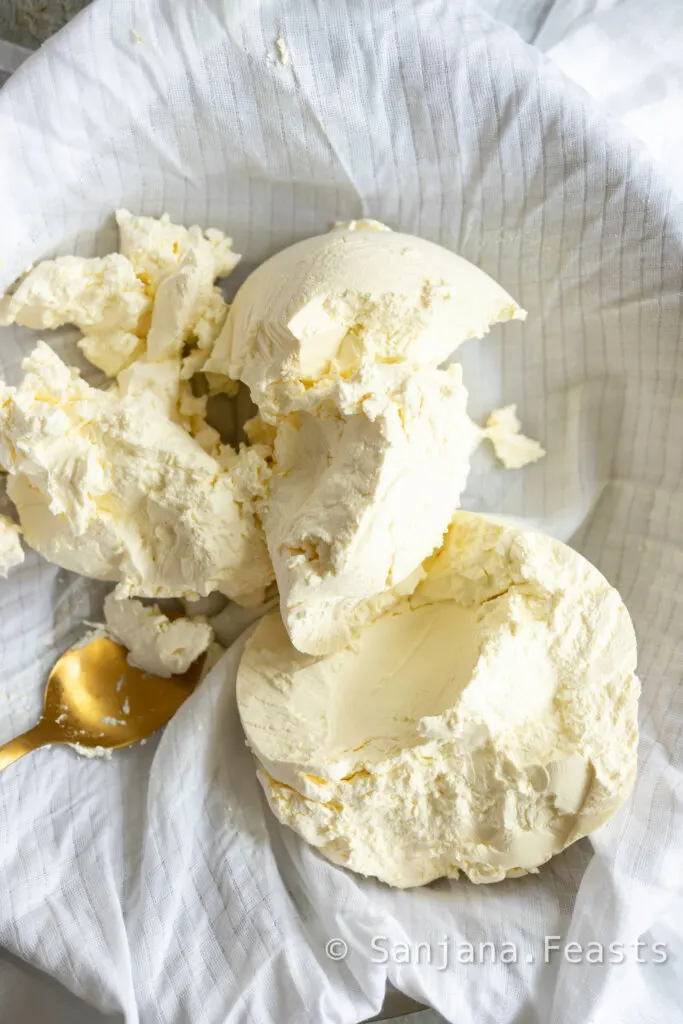
Hung yogurt is a type of yoghurt that has been strained to remove the whey, the liquid part of yoghurt.
This gives it a thicker, creamier texture and a more concentrated flavour.
Hung yoghurt is often used in Indian, Greek, Levantine and Middle Eastern cuisine.
It’s super easy to make hung yoghurt at home using a clean cheesecloth or muslin cloth strainer.
Simply place the yoghurt in the strainer and let it drain for several hours, or overnight.
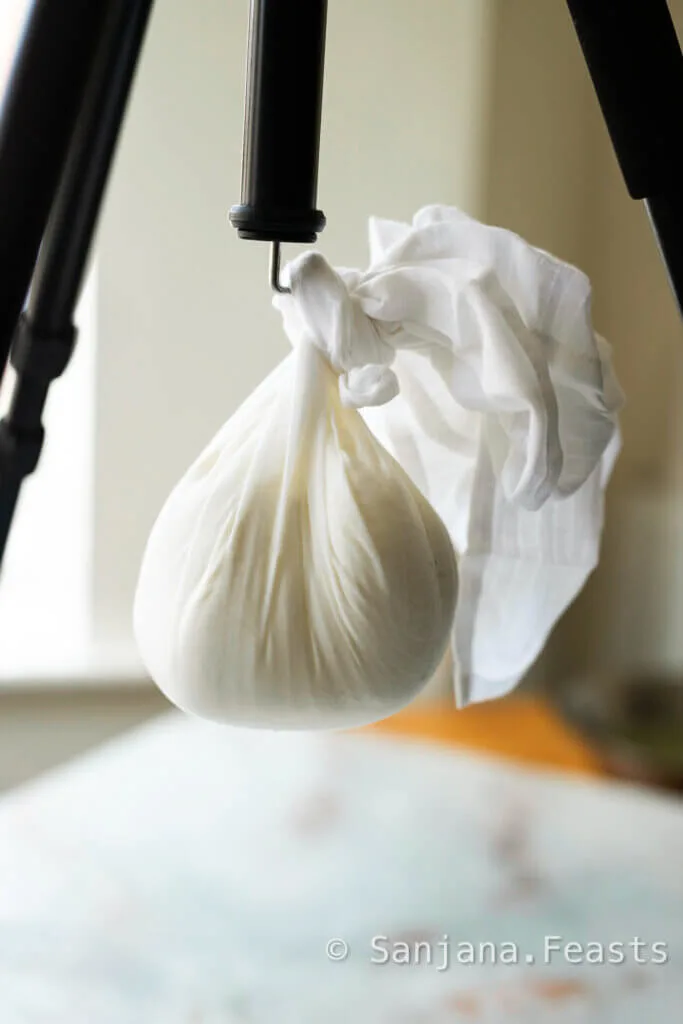
The longer you strain the yoghurt, the thicker and tangier it will become.
Where does hung yoghurt come from?
It’s said that thick hung yoghurt was first made by herders who strained their yoghurt of its’ whey to make it lighter to carry.
Indeed, strained yoghurt has been eaten in the Levant (modern-day Lebanon, Palestine, Jordan, Syria and Israel) for thousands of years.
It is a practice dating back to ancient Bedouin tribes.
Strained yoghurt can be used to make a library of delicious recipes, from savoury kebabs such as Dahi Kebabs, to sweet desserts like these Shrikhand Doughnuts.
How to serve Shrikhand Doughnuts

Split the fried, sugar-coated doughnuts in half and fill with as much Shrikhand as your heart desires.
I like to add in some strawberry slices but you can leave them out, or use any seasonal fruit.
Passion fruit is amazing in there!
Scatter with a few chopped pistachios or almonds if you like.
These need to be eaten straight away, which is usually not a problem in my house.
Can you air fry doughnuts?
Some doughnut recipes may be suitable for air frying, however it’s not a method I’ve tried with this recipe.
The outside of the doughnut may not brown very well and the inside may remain firm, like a sweet dinner roll.
I can’t recommend air frying these doughnuts, but let me know in the comments if you manage to do it successfully.
Ingredients you’ll need for Shrikhand Doughnuts


- Plain natural set yoghurt – this needs to be the most sour yoghurt you can find. Try the ‘desi’ style dahi from shops, such as Pakeeza. Greek yoghurt is okay, but generally not sour enough to achieve a traditional flavour.
- Icing sugar (powdered sugar) – this will dissolve into the yoghurt much more easily than granulated sugar
- Green cardamom – crack the pods, take the seeds out and grind to a fine powder
- Saffron – try to use the best quality saffron within your means. Greek, Spanish, Iranian and Kashmiri saffron are all great.
- Whole milk – warm this and soak the saffron in it to extract the most flavour and colour
- Strong white bread flour – the high gluten content makes this the ideal flour for making doughnuts
- Fast-action dried yeast – a quick and easy leavening option for making doughnuts
- Caster sugar – fine caster sugar for coating the fried doughnuts
- Unsalted butter – this will enrich the doughnut dough for a soft texture
- Baking powder – a touch of baking powder gives the doughnuts extra lift in the absence of egg
- Salt – any fine salt will do
- Lemon juice – fresh or bottled
- Vanilla extract – or vanilla bean paste
- Any neutral oil for deep frying – rapeseed, canola, sunflower or vegetable oil
- Sliced strawberries – optional but very delicious! Use any seasonal fruit
Step-by-step instructions for making Shrikhand Doughnuts

1. Tie the yoghurt to make strained yoghurt (hung yoghurt)
Place a clean muslin cloth (cheesecloth) into a bowl or strainer.
Add the yoghurt and tie a very tight knot at the top of where the yoghurt sits to encourage all the water to squeeze out.

Hang the muslin somewhere cool with a large bowl underneath to collect all the whey that drips out.
Leave this for 24-36 hours. The longer you leave it, the thicker it will be.
Save the whey for another recipe. It’s amazing in Kadhi.

2. Add the sugar to the strained yoghurt



Transfer the strained yoghurt to a large bowl and beat in the icing sugar.
Soak the saffron in hot milk.
Pass the mixture through a sieve, pushing it through with the back of a large spoon or with a silicone spatula.
The shrikhand will be very smooth at this stage. Do not do this in a food processor or the yoghurt will turn watery.
3. Flavour the shrikhand

Add cardamom and saffron milk. Fold everything together with a large spoon. Try not to whip or beat the shrikhand.
Add some pistachios and/or almonds for decoration.
4. Chill the shrikhand

Refrigerate the shrikhand for 6-8 hours, or overnight for the best flavour.
Make sure it’s in an airtight container or wrapped very well in cling film so that it doesn’t absorb any other food smells.
1. Mix the Shrikhand Doughnuts dough

In the bowl of a stand mixer fitted with the dough hook attachment combine the flour, yeast, sugar and baking powder.
Add the butter, salt, lemon juice and vanilla extract and mix again until the flour mixture resembles a crumble topping.
Pour the warm milk and switch the mixer on to a medium speed. A dough should come together in about 30 seconds.
Continue to run the mixer on medium-high speed for 10 minutes.
2. Proof the dough

Grease the bowl of the stand mixer with a little oil and place the dough back in.
Cover with cling film and allow to rise in a warm place for 60 minutes.
3. Shape the doughnuts and proof again

Knock the air out of the dough and briefly knead to form a ball.
Roll the dough out to around a 2cm thickness. Use an 8cm diameter (3-inch) round cookie cutter dipped in flour to stamp our rounds of dough.
The flour will prevent the dough from sticking to the cutter.
Place the cut dough onto a large, flat baking tray lined with baking parchment. Allow to rise for 30 minutes (uncovered).
4. Fry the doughnuts
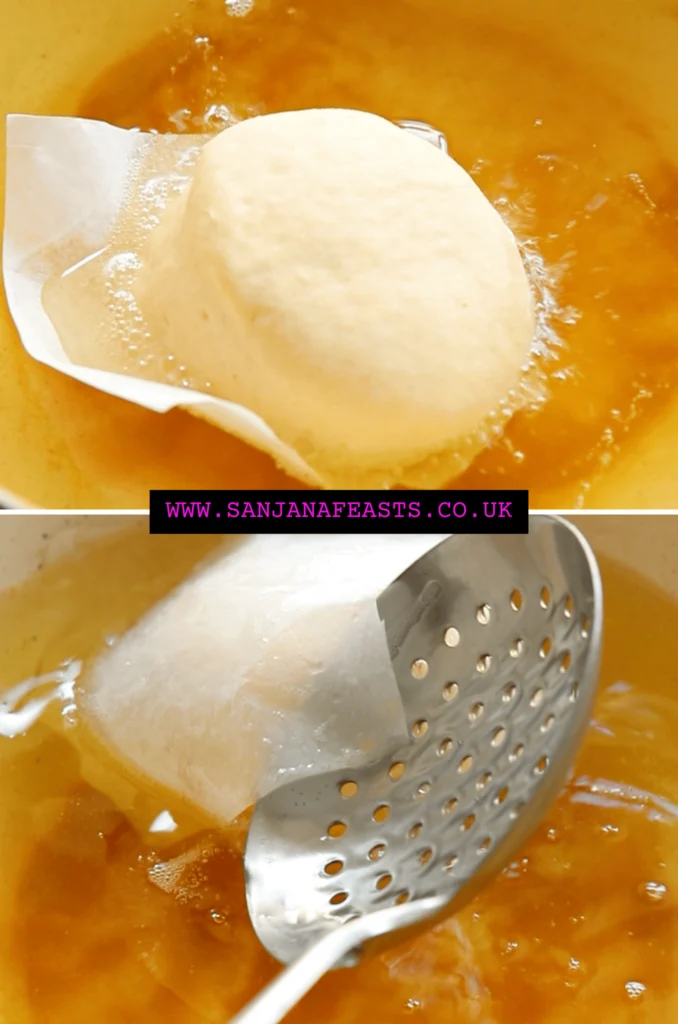
Oil temperature: 180°C/355°F. Carefully slide the risen dough onto a metal turner or wide spatula and place into the hot oil.

Alternatively, cut the baking parchment around the dough and use the sides to place the doughnuts into the oil without deflating them.
You can then remove the baking parchment from the oil and discard.
Don’t fry too many at once – 2 or 3 at a time maximum.
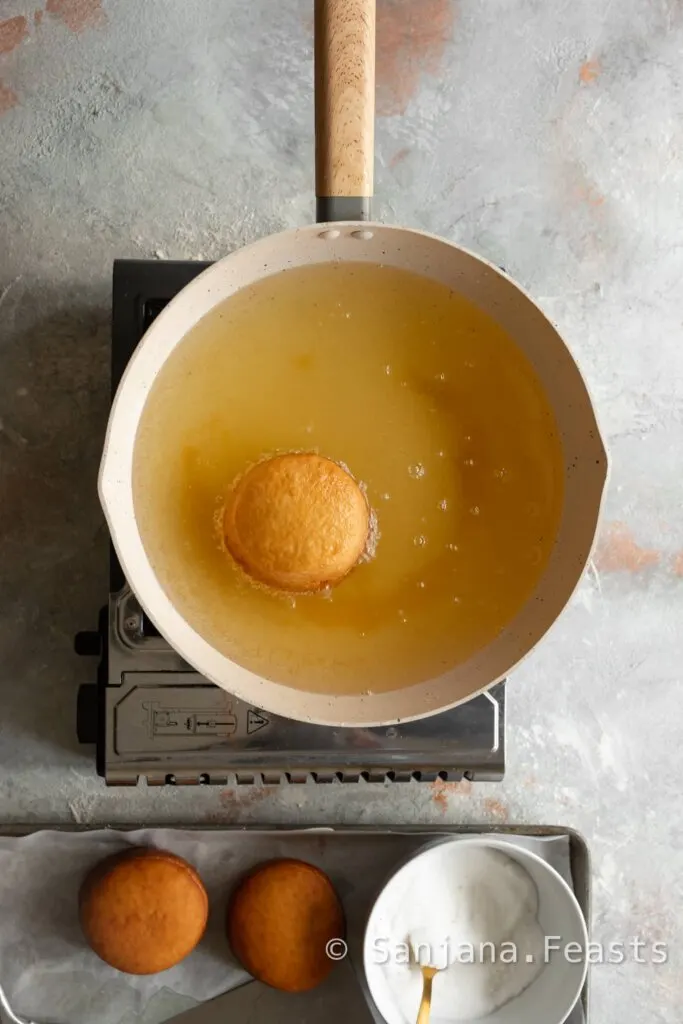
Let the doughnuts brown on one side before turning to fry the other side.
They’ll take around 2 minutes per side, so 4 minutes in total.

Drain and place them onto a tray lined with absorbent kitchen towel.

5. Make the sugar coating

To make the cardamom sugar, mix caster sugar with ground cardamom seeds (remove the green outer shell).
Alternatively, use vanilla, cinnamon or nutmeg sugar. You can also keep it plain.
6. Toss the doughnuts in sugar

Gently toss each doughnut in the sugar mixed with ground cardamom, giving them a light coating.
11. Split and fill the doughnuts with shrikhand and strawberries

Split the fried, sugar-coated doughnuts in half and fill Shrikhand.
Spoon or pipe it in, depending on how you’d like them to look.
Shrikhand Doughnuts recipe | How to make Shrikhand Doughnuts | Eggless Doughnuts filled with sweetened yoghurt
Shrikhand Doughnuts
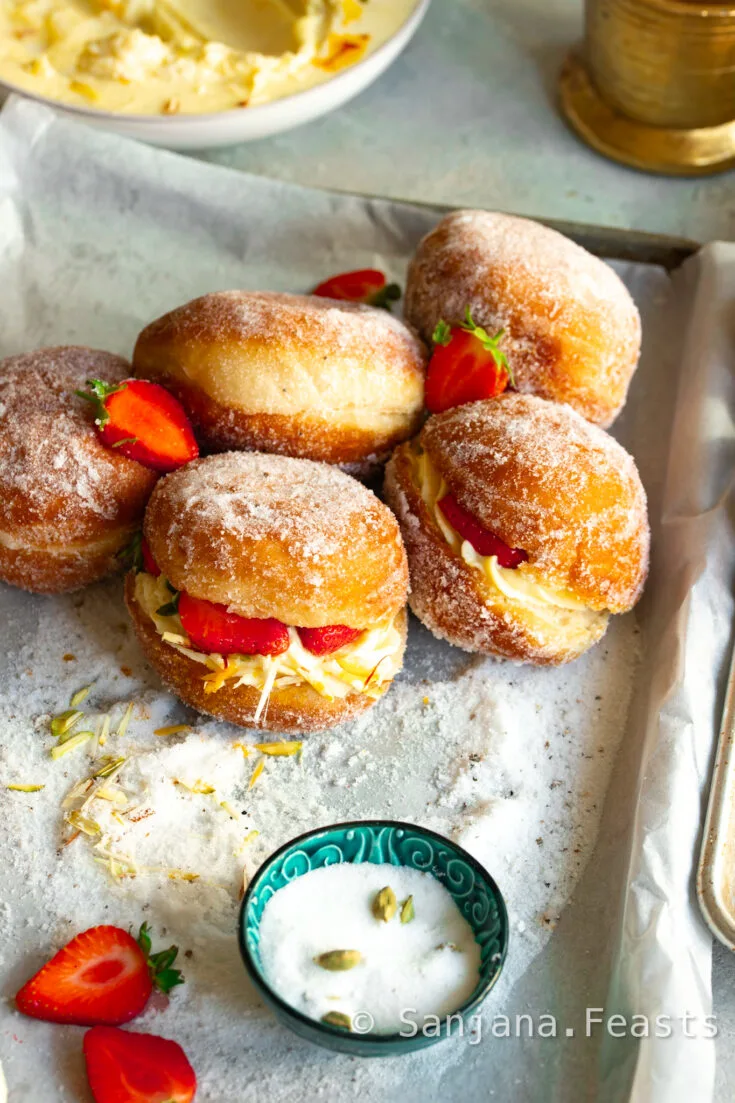
These pillowy soft Shrikhand Doughnuts are the perfect dessert for festivals like Diwali and Eid. An Indian-inspired doughnut filled with sweet, thick yoghurt flavoured with saffron and cardamom. This is an eggless doughnut recipe everybody will love. I fill the homemade doughnuts with cold shrikhand and then toss them into a cardamom sugar mixture for a crispy outside, fluffy middle and creamy core.
Ingredients
For the Shrikhand
- 1kg plain natural set yoghurt (the most sour yoghurt you can buy)
- 200g icing sugar (powdered sugar)
- 1 tsp ground green cardamom seeds (about 8 pods)
- Large pinch of saffron
- 2 tbsp warm milk
For the doughnuts
- 500g strong white bread flour, plus more for rolling
- 14g (2 sachets) fast-action dried yeast
- 40g caster sugar
- 100g unsalted butter, soft
- 1/2 tsp baking powder
- 1 tsp fine salt
- 325ml whole (full-fat) milk
- 2 tsp lemon juice
- 2 tsp vanilla extract
- Any neutral oil for deep frying
You will also need:
- 150g caster sugar
- 5 green cardamom pods, seeds finely ground
- Sliced strawberries, for serving (optional)
Instructions
- Begin by making the Shrikhand. Tip the yoghurt into a clean muslin cloth and tie it up tightly with a piece of string right above the top of the yoghurt so that the water presses away.

- Tie the muslin somewhere cool, where it can hang with a large bowl underneath to catch the water and leave it for 24-36 hours. I like to hang mine in a cool corner of the kitchen. Keep tipping away the water as the bowl fills up.

- Remove the yoghurt from the muslin and place it in a large bowl. Add the icing sugar and mix well.

- Press the yoghurt and sugar mixture through a fine-holed sieve to remove any lumps.

- Mix in the ground cardamom, saffron and pistachios if using. Chill in the fridge for at least 8 hours before serving.

- To make the doughnuts: In the bowl of a stand mixer fitted with the dough hook attachment, add the flour, yeast, sugar and baking powder. Mix on low until everything is roughly incorporated.

- Add the butter, salt, lemon juice and vanilla extract and mix again until the flour mixture resembles a crumble topping.
- Pour the milk into a saucepan or warm in the microwave until it's about 28°C/82°F. It should feel slightly warm when you place a clean finger in it, but not be so hot you can't stand it.
- Pour the milk into the dough mixture and switch the mixer on to a medium speed. A dough should come together in about 30 seconds. Continue to run the mixer on medium-high speed for 10 minutes. It should be very soft and a little sticky. Don't add any extra flour. However, if the dough is very stiff, add a few extra tablespoons of warm milk or water. The enemy of doughnuts is a dough that's not properly hydrated.
- Remove the dough from the mixer. Grease the bowl of the stand mixer with a little oil and place the dough back in. Cover with cling film and allow to rise in a warm place for 60 minutes by which time it should have doubled in size. On cold days, this could take up to 90 minutes but try not to leave it longer than that or you will have an over-proofed dough.

- Knock the air out of the dough and briefly knead to form a ball. Generously flour a large clean surface or worktop. Roll the dough out to around a 2cm thickness. Use an 8cm diameter (3-inch) round cookie cutter dipped in flour to stamp our rounds of dough. Place the cut dough onto a large, flat baking tray lined with baking parchment. Leave space around each circle as they will rise again. Gather up remaining dough scraps and continue to cut out rounds until all the dough is used up.
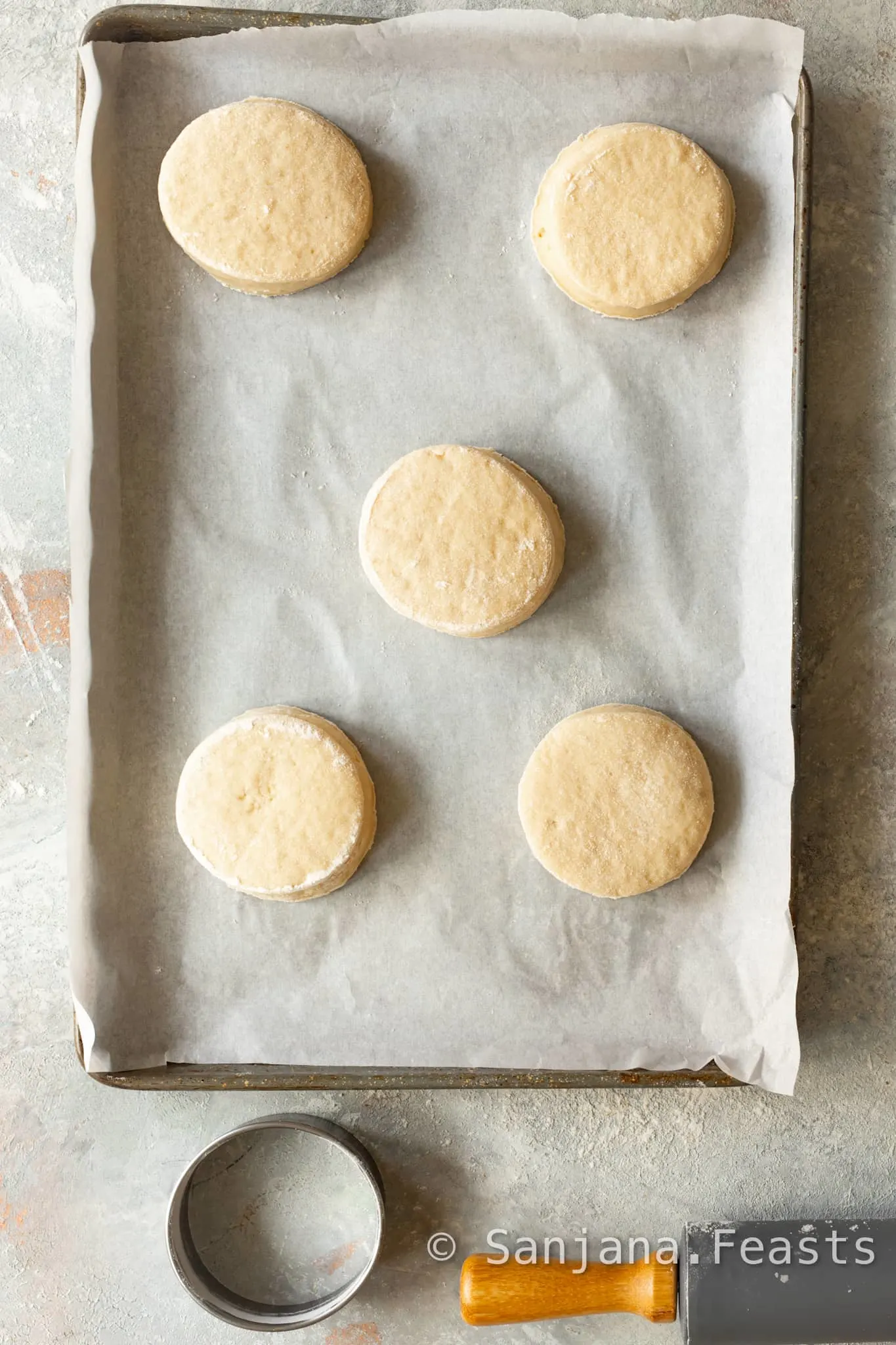
- Allow the dough to proof (rise) once more in a warm place, this time uncovered and for 30 minutes only.
- Heat enough oil for deep frying in a large, deep pan, or wok. Once the oil temperature reaches 180°C/355°F, you can begin to fry. Carefully slide the risen dough onto a metal turner or wide spatula and place into the hot oil. Alternatively, cut the baking parchment around the dough and use the sides to place the doughnuts into the oil without deflating them. You can then remove the baking parchment from the oil and discard. Don't fry too many at once - 2 or 3 at a time maximum. Let the doughnuts brown on one side before turning to fry the other side. They'll take around 2 minutes per side, so 4 minutes in total. Be sure to fry them to a lovely golden brown or they may stay doughy inside.

- Use a perforated spoon to remove the doughnuts from the oil and place them onto a tray lined with absorbent kitchen towel. Continue frying all the doughnuts this way.
- Whilst the doughnuts cool a little, mix the caster sugar and cardamom on a plate. Gently toss each doughnut in the sugar to give them a light coating. Allow to cool to room temperature, or just slightly warm.
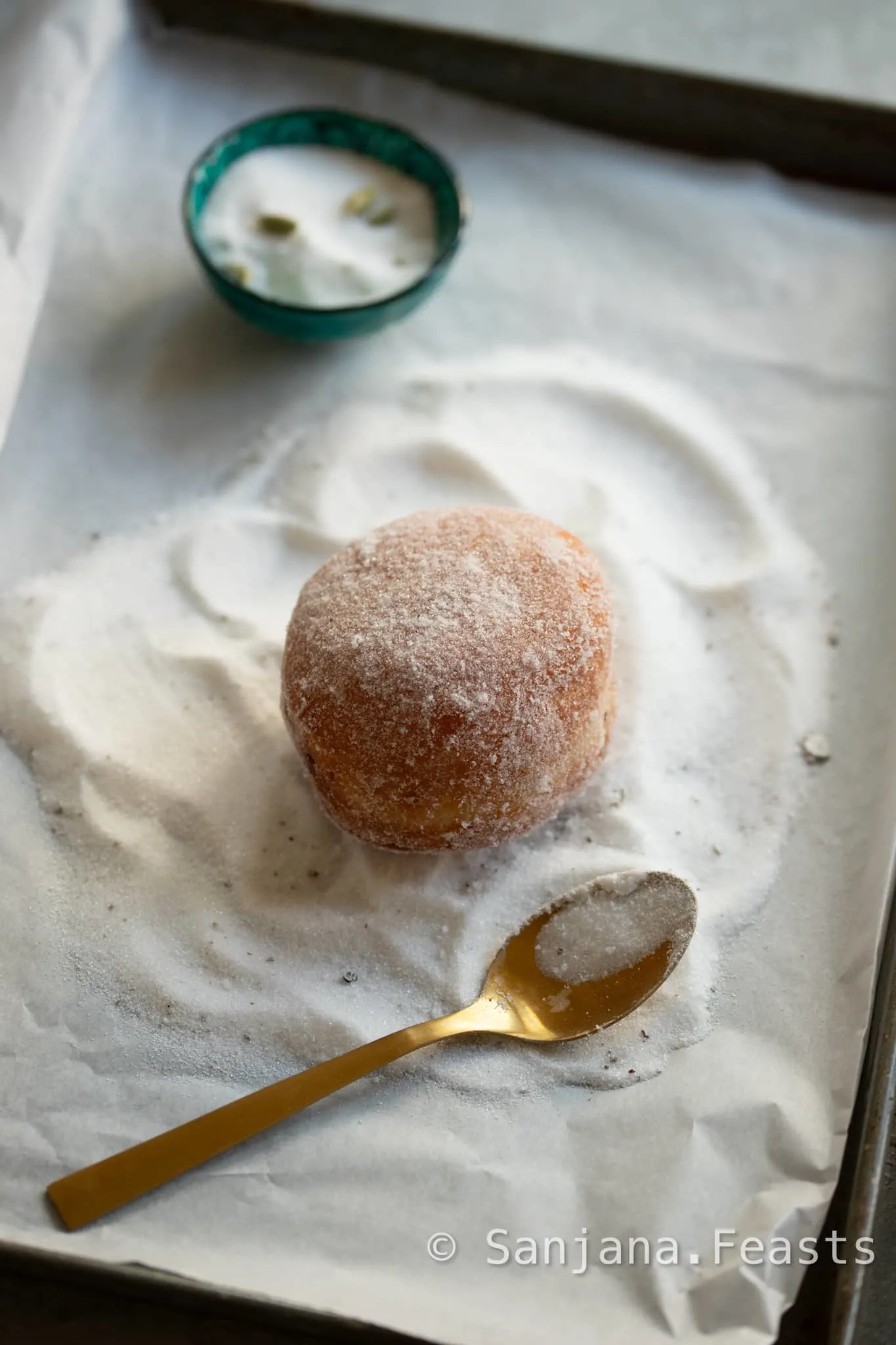
- When you're ready to serve, use a sharp, serrated knife to split the doughnuts in half. Spoon or pipe the cold Shrikhand into the doughnuts and add a few strawberries on top. Sandwich the top back on and press down a little. Carefully fill all the doughnuts this way. Serve immediately.

Notes
- This Shrikhand keeps well in the fridge for up to a week after it's made. Keep it in an airtight container.
- Shrikhand will also keep well in the freezer for up to 3 months. Defrost at room temperature.
- Store unfilled doughnuts in a closed paper bag or in airtight container at room temperature. Keeping them in the fridge will make them turn stale quickly
- The unfilled doughnuts are best eaten within 48 hours. Filled doughnuts should be eaten immediately. Always assemble just prior to serving.
- If you don't like Shrikhand, try filling with strawberry jam and/or cardamom, substitute with your favourite flavours (suggestions in blog post)
Here are some ways to test oil temperature without a thermometer for 180°C/355°F:
- Use a wooden spoon or chopstick. Dip the end of a wooden spoon or chopstick into the oil. If the oil starts to bubble around the wood, the oil is hot enough. If the oil is not bubbling, the oil is not hot enough.
- Use a piece of bread. Drop a small piece of bread into the oil. If the bread browns in 15 seconds, the oil is at 180°C/355°F. If the bread browns in more than 15 seconds, the oil is not hot enough.
It is important to note that these methods are not as accurate as using a thermometer, but they can be used in a pinch. If you are frying food that is delicate, such as doughnuts, it is best to use a thermometer to ensure that the oil is at the correct temperature.
Nutrition Information:
Yield: 8 Serving Size: 1Amount Per Serving: Calories: 514Total Fat: 14gSaturated Fat: 7gTrans Fat: 0gUnsaturated Fat: 6gCholesterol: 31mgSodium: 350mgCarbohydrates: 87gFiber: 2gSugar: 37gProtein: 9g
Pin this recipe for later!

11 Burfi Recipes to Satisfy Your Sweet Tooth
Learn how to make the traditional South Asian milk fudge, burfi with these easy and creative recipes.
9 ingredients and 30 minutes prep and cook time is all you need.
This plain milk powder burfi is the Indian sweet recipe my followers request the most. I think White Burfi has such a simple charm and universal appeal.
This quick and simple recipe for the milky, fudgy South Asian sweet, Mango Burfi requires just a handful of ingredients and the texture is just like shop bought burfi!
A must for pistachio lovers! Here's an easy recipe for melt-in-the-mouth Indian pistachio burfi made with REAL PISTACHIOS.
It has true pistachio flavours (not just food colour or pistachio essence) and of course, gold and silver leaf on top.
Perfect for gifting. Your family and friends will love it!
Perfect Besan Barfi is a meltingly soft and creamy Indian sweet with roasted gram (chickpea) flour, sugar and nuts.
Here's an entirely foolproof recipe that delivers amazing results every time.
Sweet condensed milk burfi with a hidden layer of birthday cake and sprinkles!
I created this recipe using my favourite eggless cupcake recipe and it's always a hit at parties.
What would you say if I told you that chocolate burfi + cookie dough had a party in my kitchen and things got pretty wild?
Layers of cardamom burfi, classic chocolate chip cookie dough and milk chocolate combined to create the wickedest chocolate burfi you’ll ever experience.
Mohanthal is a buttery, melt-in-the-mouth Indian sweet with gram flour, cardamom, saffron and mace. It comes from Gujarat in western India.
Enjoy as a square or as a hot fudge-like pudding with ice cream.
This super-duper chocolatey take on Indian Burfi puts Easter chocolate to work for a totally cute springtime sweet! It’s so easy and quick to make.
It is adapted from my Perfect Plain White Burfi recipe and it’s completely foolproof.
Each square of burfi is perfectly crumbly and melts in the mouth. Indian sweets have never been so simple!
These diamonds of sweet fudge have a delicious, crumbly and chewy texture from the ground cashew nuts.
Laced with ground cardamom and vanilla extract, floral undertones are created beneath a creamy layer of white chocolate.
As soon as you take a bite, the fudge begins to melt on your tongue and a burst of subtle flavours take over. Bliss.
You can make this in 10 minutes flat in the microwave. I love the sweet aromas of pandan, the Asian equivalent of vanilla.
Layer up the flavours, set and cut into large squares.
Perfect Seeroh (Sooji Burfi) is the ultimate quick-fix Indian dessert. My recipe can be ready to eat in as little as 20 minutes! I've pulled together all my best tips for making this iconic, buttery semolina sweet at home.
With love and Shrikhand Doughnuts,
Sanjana



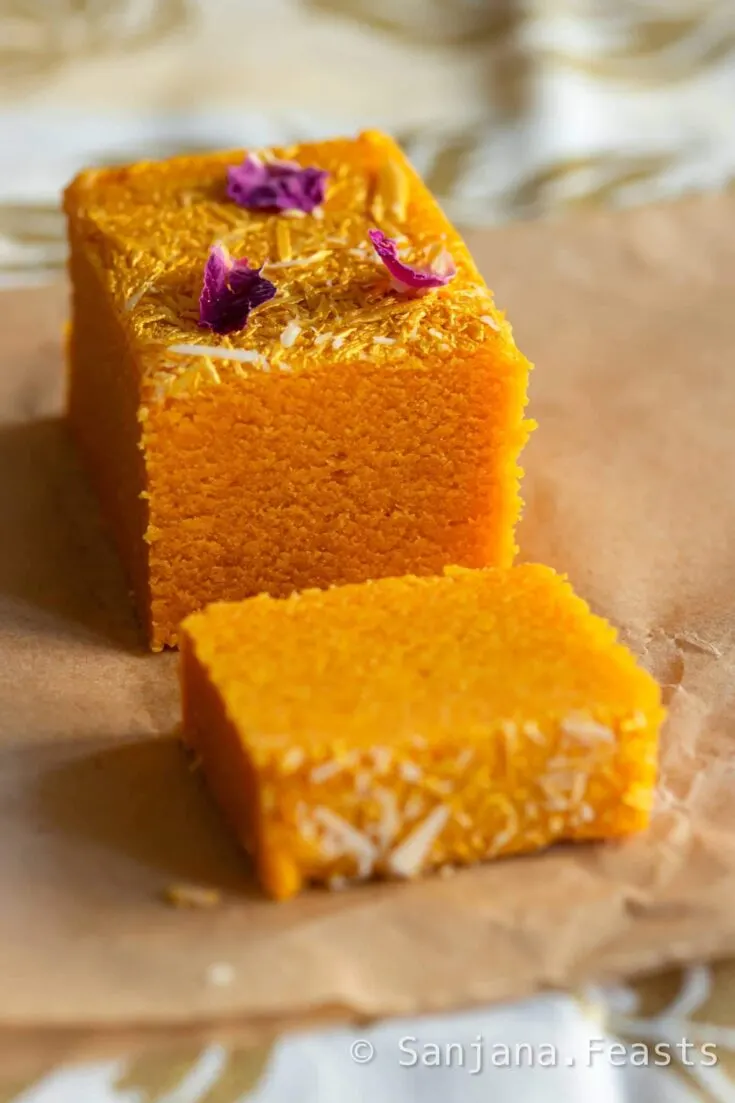


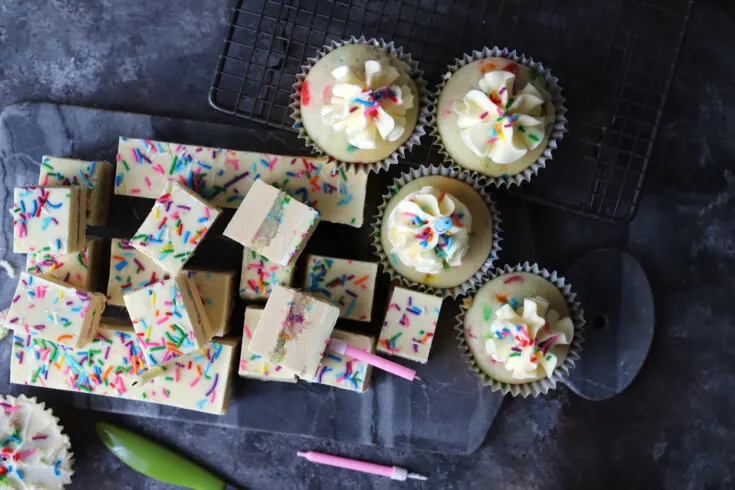






Shrikhand Recipe - Sanjana.Feasts - Indian Sweets
Monday 6th of November 2023
[…] Get my recipe for Eggless Shrikhand Doughnuts […]
Joy
Wednesday 25th of May 2011
Those look so cool
Xiaolu @ 6 Bittersweets
Wednesday 18th of May 2011
Congrats on the feature -- well deserved!!
penny aka jeroxie
Tuesday 17th of May 2011
Wow! Congras :)
RavieNomNoms
Monday 16th of May 2011
That is SUCH an interesting recipe!! Seriously...I just want to reach into my screen and give this a taste!